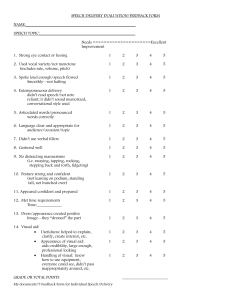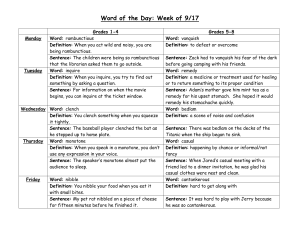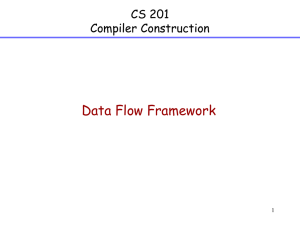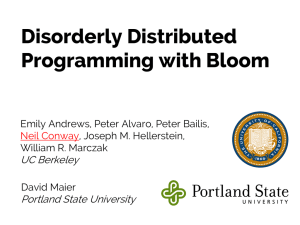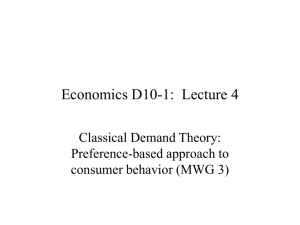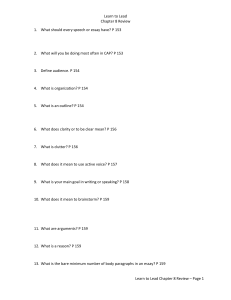Document 10450098
advertisement
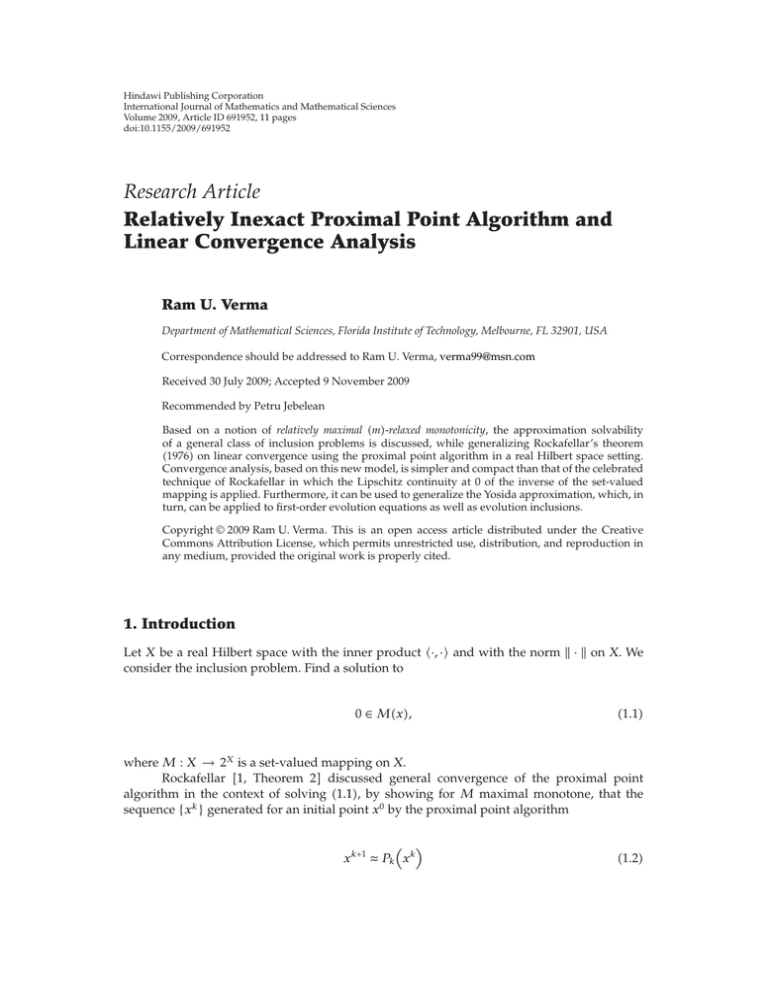
Hindawi Publishing Corporation
International Journal of Mathematics and Mathematical Sciences
Volume 2009, Article ID 691952, 11 pages
doi:10.1155/2009/691952
Research Article
Relatively Inexact Proximal Point Algorithm and
Linear Convergence Analysis
Ram U. Verma
Department of Mathematical Sciences, Florida Institute of Technology, Melbourne, FL 32901, USA
Correspondence should be addressed to Ram U. Verma, verma99@msn.com
Received 30 July 2009; Accepted 9 November 2009
Recommended by Petru Jebelean
Based on a notion of relatively maximal m-relaxed monotonicity, the approximation solvability
of a general class of inclusion problems is discussed, while generalizing Rockafellar’s theorem
1976 on linear convergence using the proximal point algorithm in a real Hilbert space setting.
Convergence analysis, based on this new model, is simpler and compact than that of the celebrated
technique of Rockafellar in which the Lipschitz continuity at 0 of the inverse of the set-valued
mapping is applied. Furthermore, it can be used to generalize the Yosida approximation, which, in
turn, can be applied to first-order evolution equations as well as evolution inclusions.
Copyright q 2009 Ram U. Verma. This is an open access article distributed under the Creative
Commons Attribution License, which permits unrestricted use, distribution, and reproduction in
any medium, provided the original work is properly cited.
1. Introduction
Let X be a real Hilbert space with the inner product ·, · and with the norm · on X. We
consider the inclusion problem. Find a solution to
0 ∈ Mx,
1.1
where M : X → 2X is a set-valued mapping on X.
Rockafellar 1, Theorem 2 discussed general convergence of the proximal point
algorithm in the context of solving 1.1, by showing for M maximal monotone, that the
sequence {xk } generated for an initial point x0 by the proximal point algorithm
xk1 ≈ Pk xk
1.2
2
International Journal of Mathematics and Mathematical Sciences
converges strongly to a solution of 1.1, provided that the approximation is made sufficiently
accurate as the iteration proceeds, where Pk I ck M−1 is the resolvent operator for a
sequence {ck } of positive real numbers, that is bounded away from zero. We observe from
1.2 that xk1 is an approximate solution to inclusion problem
0 ∈ Mx ck−1 x − xk .
1.3
Next, we state the theorem of Rockafellar 1, Theorem 2, where an approach of using
the Lipschitz continuity of M−1 instead of the strong monotonicity of M is considered, that
turned out to be more application enhanced to convex programming. Moreover, it is wellknown that the resolvent operator Pk I ck M−1 is nonexpansive, so it does not seem to
be possible to achieve a linear convergence without having the Lipschitz continuity constant
less than one in that setting. This could have been the motivation behind looking for the
Lipschitz continuity of M−1 at zero which helped achieving the Lipschitz continuity of Pk
with Lipschitz constant that is less than one instead.
Theorem 1.1. Let X be a real Hilbert space, and let M : X → 2X be maximal monotone. For an
arbitrarily chosen initial point x0 , let the sequence {xk } be generated by the proximal point algorithm
1.2 such that
k1
x − Pk xk ≤ k ,
1.4
where Pk I ck M−1 , and the scalar sequences {k } and {ck }, respectively, satisfy Σ∞
<∞
k0 k
and {ck } is bounded away from zero.
We further suppose that sequence {xk } is generated by the proximal point algorithm
1.2 such that
k1
x − Pk xk ≤ δk xk1 − xk ,
1.5
where scalar sequences {δk } and {ck }, respectively, satisfy Σ∞
δ < ∞ and ck ↑ c ≤ ∞.
k0 k
Also, assume that {xk } is bounded in the sense that the solution set to 1.1 is
nonempty, and that M−1 is a-Lipschitz continuous at 0 for a > 0. Let
μk a
a2
ck2
< 1.
1.6
Then the sequence {xk } converges strongly to x∗ , a unique solution to 1.1 with
k1
x − x∗ ≤ αk xk − x∗ ∀k ≥ k ,
1.7
International Journal of Mathematics and Mathematical Sciences
3
where
0 ≤ αk μ k δk
<1
1 − δk
∀k ≥ k ,
1.8
αk −→ 0 as ck −→ ∞.
As we observe that most of the variational problems, including minimization or
maximization of functions, variational inequality problems, quasivariational inequality
problems, minimax problems, decision and management sciences, and engineering sciences
can be unified into form 1.1, the notion of the general maximal monotonicity has played
a crucially significant role by providing a powerful framework to develop and use suitable
proximal point algorithms in exploring and studying convex programming and variational
inequalities. Algorithms of this type turned out to be of more interest because of their roles
in certain computational methods based on duality, for instance the Hestenes-Powell method
of multipliers in nonlinear programming. For more details, we refer the reader to 1–15.
In this communication, we examine the approximation solvability of inclusion
problem 1.1 by introducing the notion of relatively maximal m-relaxed monotone
mappings, and derive some auxiliary results involving relatively maximal m-relaxed
monotone and cocoercive mappings. The notion of the relatively maximal m-relaxed
monotonicity is based on the notion of A-maximal m-relaxed monotonicity introduced
and studied in 9, 10, but it seems more application-oriented. We note that our approach
to the solvability of 1.1 differs significantly than that of 1 in the sense that M is without
the monotonicity assumption; there is no assumption of the Lipschitz continuity on M−1 ,
and the proof turns out to be simple and compact. Note that there exists a huge amount of
research on new developments and applications of proximal point algorithms in literature to
approximating solutions of inclusion problems of the form 1.1 in different space settings,
especially in Hilbert as well as in Banach space settings.
2. Preliminaries
In this section, first we introduce the notion of the relatively maximal m-relaxed monotonicity,
and then we derive some basic properties along with some auxiliary results for the problem
on hand.
Let X be a real Hilbert space with the norm · for X, and with the inner product ·, ·.
Definition 2.1. Let X be a real Hilbert space, and let M : X → 2X be a multivalued mapping
and A : X → X a single-valued mapping on X. The map M is said to be the following.
i Monotone if
u∗ − v∗ , u − v ≥ 0
∀u, u∗ , v, v∗ ∈ graphM.
2.1
ii Strictly monotone if M is monotone and equality holds only if u v.
iii r-strongly monotone if there exists a positive constant r such that
u∗ − v∗ , u − v ≥ ru − v2
∀u, u∗ , v, v∗ ∈ graphM.
2.2
4
International Journal of Mathematics and Mathematical Sciences
iv r-expanding if there exists a positive constant r such that
u∗ − v∗ ≥ ru − v
∀u, u∗ , v, v∗ ∈ graphM.
2.3
v Strongly monotone if
u∗ − v∗ , u − v ≥ u − v2
∀u, u∗ , v, v∗ ∈ graphM.
2.4
vi Expanding if
u∗ − v∗ ≥ u − v
∀u, u∗ , v, v∗ ∈ graphM.
2.5
vii m-relaxed monotone if there is a positive constant m such that
u∗ − v∗ , u − v ≥ −mu − v2
∀u, u∗ , v, v∗ ∈ graphM.
2.6
viii c-cocoercive if there exists a positive constant c such that
u∗ − v∗ , u − v ≥ cu∗ − v∗ 2
∀u, u∗ , v, v∗ ∈ graphM.
2.7
ix Monotone with respect to A if
u∗ − v∗ , Au − Av ≥ 0
∀u, u∗ , v, v∗ ∈ graphM.
2.8
x Strictly monotone with respect to A if M is monotone with respect to A and equality
holds only if u v.
xi r-strongly monotone with respect to A if there exists a positive constant r such
that
u∗ − v∗ , Au − Av ≥ ru − v2
∀u, u∗ , v, v∗ ∈ graphM.
2.9
xii m-relaxed monotone with respect to A if there exists a positive constant m such
that
u∗ − v∗ , Au − Av ≥ −mu − v2
∀u, u∗ , v, v∗ ∈ graphM.
2.10
xiii h-hybrid relaxed monotone with respect to A if there exists a positive constant h
such that
u∗ − v∗ , Au − Av ≥ −hAu − Av2
∀u, u∗ , v, v∗ ∈ graphM.
2.11
International Journal of Mathematics and Mathematical Sciences
5
xiv m-cocoercive with respect to A if there exists a positive constant m such that
u∗ − v∗ , Au − Av ≥ mu∗ − v∗ 2
∀u, u∗ , v, v∗ ∈ graphM.
2.12
Definition 2.2. Let X be a real Hilbert space, and let M : X → 2X be a mapping on X.
Furthermore, let A : X → X be a single-valued mapping on X. The map M is said to be
the following.
i Nonexpansive if
u∗ − v∗ ≤ u − v
∀u, u∗ , v, v∗ ∈ graphM.
2.13
ii Cocoercive if
u∗ − v∗ , u − v ≥ u∗ − v∗ 2
∀u, u∗ , v, v∗ ∈ graphM.
2.14
iii Cocoercive with respect to A if
u∗ − v∗ , Au − Av ≥ u∗ − v∗ 2
∀u, u∗ , v, v∗ ∈ graphM.
2.15
Definition 2.3. Let X be a real Hilbert space. Let A : X → X be a single-valued mapping. The
map M : X → 2X is said to be relatively maximal m-relaxed monotone with respect to A
if
i M is m-relaxed monotone with respect to A for m > 0,
ii RI ρM X for ρ > 0.
Definition 2.4. Let X be a real Hilbert space. Let A : X → X be a single-valued mapping. The
map M : X → 2X is said to be relatively maximal monotone with respect to A if
i M is monotone with respect to A,
ii RI ρM X for ρ > 0.
Definition 2.5. Let X be a real Hilbert space, and let A : X → X be r-strongly monotone.
Let M : X → 2X be a relatively maximal m-relaxed monotone mapping. Then the resolvent
M
: X → X is defined by
operator Jρ,m,A
−1
M
Jρ,m,A
u I ρM u
for r − ρm > 0.
2.16
Proposition 2.6. Let X be a real Hilbert space. Let A : X → X be an r-strongly monotone
mapping, and let M : X → 2X be a relatively maximal m-relaxed monotone mapping. Then the
M
I ρM−1 is single valued for r − ρm > 0.
resolvent operator Jρ,m,A
6
International Journal of Mathematics and Mathematical Sciences
Proof. For any z ∈ X, assume x, y ∈ I ρM−1 z. Then we have
−x z ∈ ρMx,
−y z ∈ ρM y .
2.17
Since M is relatively maximal m-relaxed monotone, and A is r-strongly monotone, it
follows that
2
2
−ρmx − y ≤ − x − y, Ax − A y ≤ −r x − y
2
⇒ r − ρm x − y ≤ 0
⇒ x y
2.18
for r − ρm > 0.
Definition 2.7. Let X be a real Hilbert space. A map M : X → 2X is said to be maximal
monotone if
i M is monotone,
ii RI ρM X for ρ > 0.
Note that all relatively monotone mappings are relatively m-relaxed monotone for
m > 0. We include an example of the relative monotonicity and other of the relative h-hybrid
relaxed monotonicity, a new notion to the problem on hand.
Example 2.8. Let X −∞, ∞, Ax −1/2x, and Mx −x for all x ∈ X. Then M
is relatively monotone but not monotone, while M is relatively m-relaxed monotone for
m > 0.
Example 2.9. Let X be a real Hilbert space, and let M : X → 2X be maximal m-relaxed
monotone. Then we have the Yosida approximation Mρ ρ−1 I −JρM , where JρM I ρM−1
is the resolvent of M, that satisfies
2
Mρ u − Mρ v, JρM u − JρM v ≥ −mJρM u − JρM v ,
2.19
that is, Mρ is relatively m-hybrid relaxed monotone with respect to JρM .
3. Generalization to Rockafellar’s Theorem
This section deals with a generalization to Rockafellar’s theorem 1, Theorem 2 in light of
the new framework of relative maximal m-relaxed monotonicity, while solving 1.1.
Theorem 3.1. Let X be a real Hilbert space, let A : X → X be r-strongly monotone, and let M :
X → 2X be relatively maximal m-relaxed monotone. Then the following statements are mutually
International Journal of Mathematics and Mathematical Sciences
7
equivalent:
i an element u ∈ X is a solution to 1.1,
ii for an u ∈ X, one has
u RM
ρ,m,A u,
3.1
where
−1
RM
u
ρ,m,A u I ρM
for r − ρm > 0.
3.2
Proof. To show i ⇒ ii, if u ∈ X is a solution to 1.1, then for ρ > 0 we have
or
0 ∈ ρMu
u ∈ I ρM u
or
RM
ρ,m,A u u.
3.3
Similarly, to show ii ⇒ i, we have
u RM
ρ,m,A u
⇒ u ∈ I ρM u
⇒ 0 ∈ ρMu
3.4
⇒ 0 ∈ Mu.
Theorem 3.2. Let X be a real Hilbert space, let A : X → X be r-strongly monotone, and let
M : X → 2X be relatively maximal m-relaxed monotone. Furthermore, suppose that M : X → 2X
M
is relatively h-hybrid relaxed monotone and (AoRM
ρk ,m,A is γ-cocoercive with respect to Rρk ,m,A .
i For an arbitrarily chosen initial point x0 , suppose that the sequence {xk } is
generated by the proximal point algorithm 1.2 such that
k1
k ≤ k ,
x − RM
ρk ,m,A x
3.5
−1
where Σ∞
< ∞, r − ρk m > 0, RM
ρk ,m,A I ρk M , and the scalar sequence {ρk } satisfies
k0 k
ρk ↑ ρ ≤ ∞. Suppose that the sequence {xk } is bounded in the sense that the solution set of
1.1 is nonempty.
ii In addition to assumptions in i, we further suppose that, for an arbitrarily chosen
initial point x0 , the sequence {xk } is generated by the proximal point algorithm 1.2 such that
k1
k ≤ δk xk1 − xk ,
x − RM
ρk ,m,A x
3.6
8
International Journal of Mathematics and Mathematical Sciences
−1
where δk → 0, RM
ρk ,m,A I ρk M , and the scalar sequences {δk } and {ρk }, respectively,
∞
satisfy Σk0 δk < ∞, and ρk ↑ ρ ≤ ∞. Then the following implications hold:
iii the sequence {xk } converges strongly to a solution of 1.1,
iv rate of convergences
0 ≤ lim
k→∞
δk −1
γ − hρk r
< 1,
1 − δk
3.7
where 1/γ − hρk r < 1.
Proof. Suppose that x∗ is a zero of M. We begin with the proof for
M
∗ Rρk ,m,A xk − RM
ρk ,m,A x ≤ 1
xk − x∗ ,
γ − hρk r
3.8
where γ − hρk > 0. It follows from the definition of the generalized resolvent operator RM
ρk ,m,A ,
the relative h-hybrid relaxed monotonicity of M with respect to A and the γ-cocoercivity
M
of AoRM
ρk ,m,A with respect to Rρk ,m,A that
k
M
∗
M
k
M
∗
,
A
R
x
−
R
x
−
A
R
xk − x∗ − RM
x
x
ρk ,m,A
ρk ,m,A
ρk ,m,A
ρk ,m,A
2
k
M
∗ ≥ −hρk ARM
x
−
A
R
x
ρk ,m,A
ρk ,m,A
3.9
or
k
∗
− A RM
xk − x∗ , A RM
ρk ,m,A x
ρk ,m,A x k
M
∗
M
k
M
∗
≥ RM
x
−
R
x
−
A
R
A
R
x
,
x
ρk ,m,A
ρk ,m,A
ρk ,m,A
ρk ,m,A
2
k
M
∗ − hρk ARM
x
−
A
R
x
ρk ,m,A
ρk ,m,A
3.10
2
k
M
∗ ≥ γ ARM
x
−
A
R
x
ρk ,m,A
ρk ,m,A
2
k
M
∗ − hρk ARM
x
−
A
R
x
.
ρk ,m,A
ρk ,m,A
Next, we move to estimate
k1
k
− x∗ k
x − x∗ ≤ RM
ρk ,m,A x
k
M
∗ x
−
R
RM
x
k
ρk ,m,A
ρk ,m,A
1
≤
xk − x∗ k .
γ − hρk r
3.11
International Journal of Mathematics and Mathematical Sciences
9
For γ − hρk r > 1, combining the previous inequality for all k, we have
k
∞
k1
x − x∗ ≤ x0 − x∗ i ≤ x0 − x∗ k .
i0
3.12
k0
Hence, {xk } is bounded.
Next we turn our attention to convergence part of the proof. Since
k1
k k
∗ − RM
RM
x − x∗ ≤ xk1 − RM
ρk ,m,A x
ρk ,m,A x
ρk ,m,A x ,
k1
k1
k1
k
k k
∗
∗
x
≤
δ
≤
δ
−
x
−
x
−
x
x − RM
x
x
x
,
k
k
ρk ,m,A
3.13
we get
k1
k x − x∗ ≤ xk1 − RM
ρk ,m,A x
k
∗ RM
− RM
ρk ,m,A x
ρk ,m,A x ≤ δk xk1 − x∗ xk − x∗ 3.14
1
xk − x∗ ,
γ − hρk r
where 1/γ − hρk r < 1.
It follows that
γ − hρk r −1 δk k
k1
∗
x − x∗ .
x − x ≤
1 − δk
3.15
It appears that 3.15 holds since 1/γ − hρk r < 1 seems to hold and δk → 0.
Hence, the sequence {xk } converges strongly to x∗ .
To conclude the proof, we need to show the uniqueness of the solution to 1.1. Assume
that x∗ is a zero of M. Then using xk − x∗ ≤ x0 − x∗ ∞
k0 k ∀k, we have that
a∗ lim infxk − x∗ k→∞
3.16
is nonnegative and finite, and as a result, xk − x∗ → a∗ . Consider x1∗ and x2∗ to be two limit
points of {xk }, then we have
k
x − x1∗ a1 ,
k
x − x2∗ a2 ,
3.17
10
International Journal of Mathematics and Mathematical Sciences
and both exist and are finite. If we express
2 2
2
k
x − x2∗ xk − x1∗ 2 xk − x1∗ , x1∗ − x2∗ x1∗ − x2∗ ,
3.18
then it follows that
lim
k→∞
1
2 xk − x1∗ , x1∗ − x2∗ a22 − a21 − x1∗ − x2∗ .
2
3.19
Since x1∗ is a limit point of {xk }, the left hand side limit must tend to zero. Therefore,
2
a21 a22 − x1∗ − x2∗ .
3.20
2
a22 a21 − x1∗ − x2∗ .
3.21
Similarly, we obtain
This results in x1∗ x2∗ .
∗
Remark 3.3. When M : X → 2X equals ∂f, the subdifferential of f, where f : X → −∞, ∞
is a functional on a Hilbert space X, can be applied for minimizing f. The function f is proper
if f /
≡ ∞ and is convex if
f 1 − λx λy ≤ 1 − λfx λf y ,
3.22
where x, y ∈ X and 0 < λ < 1. Furthermore, the function f is lower semicontinuous on X if
the set
x : x ∈ X, fx ≤ λ ∀λ ∈ R
3.23
is closed in X.
∗
The subdifferential ∂f : X → 2X of f at x is defined by
∂fx x∗ ∈ X ∗ : f y − fx ≥ y − x, x∗ ∀y ∈ X .
3.24
In an earlier work 7, Rockafellar has shown that if f is a lower semicontinuous proper
∗
convex functional on X, then ∂f : X → 2X is maximal monotone on X, where X is any real
Banach space. Several other special cases can be derived.
Suppose that A : X → X is strongly monotone and γ-cocoercive, and let f : X → R
∗
be τ-locally Lipschitz for τ ≥ 0 such that ∂f : X → 2X is m-relaxed monotone with
International Journal of Mathematics and Mathematical Sciences
11
respect to A, that is,
u∗ − v∗ , Au − Av ≥ −u − v2
∀u, v ∈ X,
3.25
where u∗ ∈ ∂fu, and v∗ ∈ ∂fv. Then ∂f is relatively maximal m-relaxed monotone.
Acknowledgment
The author is greatly indebted to Professor Petru Jebelean and reviewers for their valuable
comments and suggestions leading to the revised version.
References
1 R. T. Rockafellar, “Monotone operators and the proximal point algorithm,” SIAM Journal on Control
and Optimization, vol. 14, no. 5, pp. 877–898, 1976.
2 R. P. Agarwal and R. U. Verma, “The over-relaxed η−proximal point algorithm and nonlinear
variational inclusion problems,” Nonlinear Functional Analysis and Applications. In press.
3 R. P. Agarwal and R. U. Verma, “Role of relative A-maximal monotonicity in overrelaxed proximal
point algorithms with applications,” Journal of Optimization Theory and Applications, vol. 143, no. 1, pp.
1–15, 2009.
4 H.-Y. Lan, Y. J. Cho, and R. U. Verma, “Nonlinear relaxed cocoercive variational inclusions involving
A, η-accretive mappings in Banach spaces,” Computers & Mathematics with Applications, vol. 51, no.
9-10, pp. 1529–1538, 2006.
5 A. Moudafi and M. Théra, “Finding a zero of the sum of two maximal monotone operators,” Journal
of Optimization Theory and Applications, vol. 94, no. 2, pp. 425–448, 1997.
6 R. T. Rockafellar, “Augmented Lagrangians and applications of the proximal point algorithm in
convex programming,” Mathematics of Operations Research, vol. 1, no. 2, pp. 97–116, 1976.
7 R. T. Rockafellar, “On the maximal monotonicity of subdifferential mappings,” Pacific Journal of
Mathematics, vol. 33, pp. 209–216, 1970.
8 P. Tossings, “The perturbed proximal point algorithm and some of its applications,” Applied
Mathematics and Optimization, vol. 29, no. 2, pp. 125–159, 1994.
9 R. U. Verma, “A-monotonicity and its role in nonlinear variational inclusions,” Journal of Optimization
Theory and Applications, vol. 129, no. 3, pp. 457–467, 2006.
10 R. U. Verma, “A-monotone nonlinear relaxed cocoercive variational inclusions,” Central European
Journal of Mathematics, vol. 5, no. 2, pp. 386–396, 2007.
11 R. U. Verma, “A generalization to variational convergence for operators,” Advances in Nonlinear
Variational Inequalities, vol. 11, no. 2, pp. 97–101, 2008.
12 R. U. Verma, “Approximation solvability of a class of nonlinear set-valued variational inclusions
involving A, η-monotone mappings,” Journal of Mathematical Analysis and Applications, vol. 337, no.
2, pp. 969–975, 2008.
13 E. Zeidler, Nonlinear Functional Analysis and Its Applications. I, Fixed-Point Theorems, Springer, New
York, NY, USA, 1986.
14 E. Zeidler, Nonlinear Functional Analysis and Its Applications. II/B, Nonlinear Monotone Operators,
Springer, New York, NY, USA, 1990.
15 E. Zeidler, Nonlinear Functional Analysis and Its Applications. III, Variational Methods and Optimization, Springer, New York, NY, UAS, 1985.

